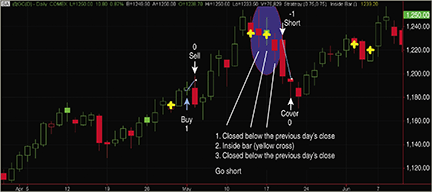TRADING SYSTEMS
How It Works On Gold And Silver And Crude
Three-Bar Inside Bar Pattern 
This trading strategy uses an inside bar as a three-bar pattern for long and short positions. Find out how it performed on gold, silver, and crude oil contracts.
Whether you look at an intraday, daily, weekly, or monthly chart you will, without a doubt, see many inside bars. They appear in uptrends, downtrends, and sideways markets. Typically, most traders think of an inside bar as a two-bar pattern, but I have found successful trades using an inside bar pattern as a three-bar pattern for both long and short signals. An inside bar accompanied by higher closes indicates a short-term uptrend, and an inside bar accompanied by lower closes indicates a short-term downtrend.
I tested this setup on daily data from May 2001 to August 2010 on three major commodities: gold (GC), silver (SI), and crude oil (CL). The results are worth some consideration.
The inside bar
The typical inside bar two-bar view indicates minimal activity in a market. It is defined as a bar (or series of bars) that is completely within the range of the preceding bar; that is, it has a higher low and lower high than the bar immediately before it.
Some traders consider a bar an inside bar if the high and low are equal to the previous bar or where there are several consecutive bars within the range of a previous bar. The “Inside Bar Show Me” study in TradeStation will not mark bars that meet either of these conditions.
Many analysts tend to view inside bars as an indication of declining market activity, or possibly a prelude to a large movement in either direction.
Trade rules
Three-bar inside bar pattern:
This pattern is divided into the following two categories:
- Three-bar inside bar positive reversal
- Three-bar inside bar negative reversal
If an inside bar formed inside two higher closes, then it is considered to be a three-bar inside bar positive reversal.

Figure 1: SHORT ENTRY SIGNAL. Here you see a three-bar inside bar setup from May 13 to May 17, 2010. This was a profitable short-term short signal.